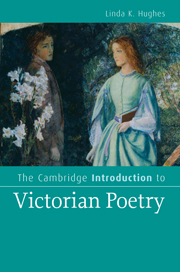Introducing Victorian poetry
Published online by Cambridge University Press: 05 June 2012
Summary
Of the difficulties that waylay a Victorian anthologist two are obvious. Where is he to begin? – Where to end? … Wordsworth happened to be the first Laureate of Queen Victoria's reign … [A]fter many months spent in close study of Victorian verse … I rise from the task in reverence and wonder not only at the mass (not easily sized) of poetry written with ardour in these less-than-a-hundred years, but at the amount of it which is excellent.
Arthur Quiller-Couch, The Oxford Book of Victorian VerseOne distinction of Victorian poetry is the degree to which serious work and popular culture converged, as evidenced by snippets of poems now proverbial: “'Tis better to have loved and lost / Than never to have loved at all”; “God's in his heaven – / All's right with the world!”; “How do I love thee? Let me count the ways.” These lines, from Alfred Tennyson's In Memoriam (1850), Robert Browning's Pippa Passes (1841), and Elizabeth Barrett Browning's Sonnets from the Portuguese (1850) become reassuring clichés when shorn of their contexts. The poems themselves offer less conventional assurance: In Memoriam involves a male poet's impassioned grief for another man; Pippa's hope is sung against the backdrop of adultery and murder; and Barrett Browning's larger sequence opens by alluding to Theocritus and fleeing from love.
The best Victorian poetry is complex, challenging, and experimental, and it was read widely, thanks to its circulation during the first era of mass media.
- Type
- Chapter
- Information
- The Cambridge Introduction to Victorian Poetry , pp. 1 - 12Publisher: Cambridge University PressPrint publication year: 2010
- 1
- Cited by

